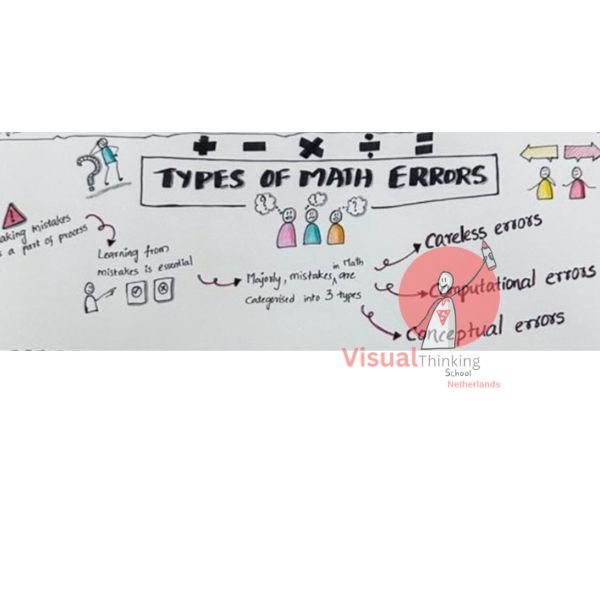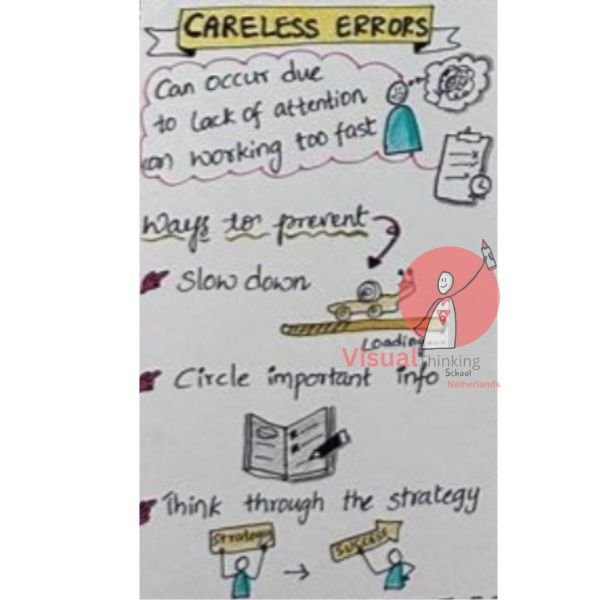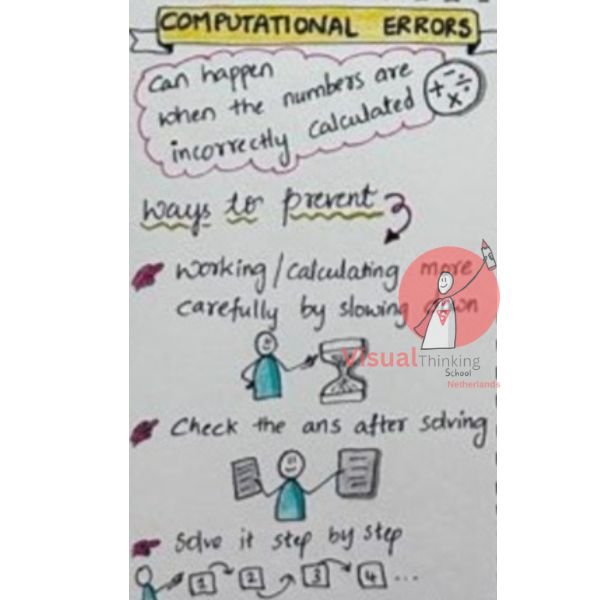
Mathematics, in its essence, is a discipline that champions accuracy and logical reasoning. Yet, it’s not uncommon to come across errors during our journey of solving mathematical problems. These errors range from the simple slip of a pencil to more deep-rooted misunderstandings about concepts. In this blog, we will delve into three major types of maths errors and provide guidelines on how to prevent them along with understanding it using maths sketchnote.

Almost every math learner has encountered careless errors. These are the mistakes that happen not because you don’t understand the concept but due to inattention or haste.
How to prevent careless errors:
The name says it all: “careless”. Often, these mistakes stem from rushing. By slowing down and taking a moment to process each step, you can significantly reduce the occurrence of these errors.
Whether you’re working through a word problem or a complex equation, circling or highlighting vital numbers or instructions can help keep them front and center in your mind.
Before jumping into solving a problem, take a moment to mentally map out your approach. A few seconds of strategizing can save you minutes of backtracking and correcting.

These are mistakes that occur during the calculation process, often when executing basic arithmetic or when manipulating mathematical symbols and expressions.
Guidelines to prevent computational errors:
It may sound simple, but ensuring that you’re in a good environment for doing maths (quiet, well-lit, and distraction-free) can reduce computational mistakes.
After arriving at an answer, it’s worth the time to go back and double-check your calculations. Sometimes, you might spot a multiplication error or an addition slip-up upon a second look.
Especially for complex problems, breaking the solution down into smaller, more manageable steps can help in ensuring each calculation is correct. This way, even if you make an error, it will be easier to pinpoint and correct.

Arguably the most concerning of the three, conceptual errors arise from misunderstandings or misconceptions about a particular mathematical idea or principle.
How to address conceptual errors:
Many mathematical concepts can be grasped more easily with the help of visual aids. For instance, fractions can be understood using pie charts or bars, and geometry is often more comprehensible with the use of shapes and diagrams.
Everyone learns differently. While one student might understand a concept through an equation, another might find an analogy or a story more helpful. Using diverse teaching methods caters to different learning styles.
Instead of just memorizing formulas, delve into the reasons behind them. For example, instead of just stating the Pythagorean Theorem, demonstrate it with squares on the sides of a right triangle.
Engage in discussions about mathematical concepts. This can be between a teacher and student, among students, or even self-reflection. Talking through a concept can help solidify understanding and reveal any underlying misconceptions.

In conclusion, errors in mathematics, though frustrating, are a natural part of the learning process. By recognizing the type of error and having strategies in place to address them, students can not only correct these mistakes but also deepen their understanding of the subject. Whether it’s taking an extra moment to double-check a calculation, using visual aids, or engaging in a thoughtful discussion about a concept, each step brings us closer to mastering the art and science of mathematics.

We conduct online and in-person certification trainings on our Trade Marked Training on Business Sketchnotes ™.
We have an open challenge in our trainings : If you can not draw after our 9 hours of trainings, we will close our trainings FOR EVER !! ..and we are still waiting for that one person even after training more than 38000 professionals.
You can also join our whatsapp community to learn from those who have attended our trainings

We trained more than 38000 professional and gave corporate trainings in more than 65+ top notch companies

Check Our Trainings

Maths educator by profession and sketchnoter by passion. She loves teaching maths using sketchnotes. She is also an acredited school sketchnote trainer with Visual Thinking School, Netherlands.
More of her sketchnotes can be checked on her Instagram: @Lavanya_anugula